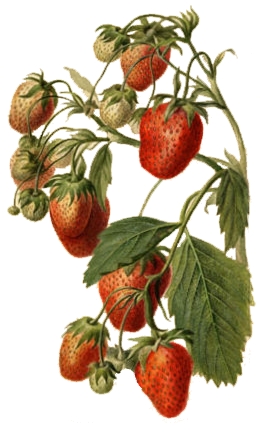- Fragaria
Taxobox
color = lightgreen
name = Strawberry

image_width = 240px
image_caption =
regnum =Plant ae
divisio = Magnoliophyta
classis =Magnoliopsida
ordo =Rosales
familia =Rosaceae
subfamilia =Rosoideae
genus = "Fragaria"
genus_authority = L.
subdivision_ranks =Species
subdivision = "20+ species; see text""Fragaria" is the name of a
genus ofplant s in the family "Rosaceae ", commonly known as strawberries for their ediblefruit s. There are more than 20 describedspecies and many hybrids andcultivar s. The most common strawberries grown commercially are cultivars of theGarden strawberry . Strawberries have a taste that varies by cultivar, and ranges from quite sweet to rather tart. Strawberries are an important commercial fruit crop, widely grown in all temperate regions of the world.Morphology
The strawberry is an
accessory fruit ; that is, the fleshy part is derived not from the ovaries which are the "seeds" (actuallyachene s) but from the peg at the bottom of thehypanthium that held the ovaries. So from a technical standpoint, the seeds are the actual fruits of the plant, and the flesh of the strawberry is modified receptacle tissue. It is whitish-green as it develops and in most species turns red when ripe. All strawberries have seeds that are visible from the outside.History
The woodland strawberry, "F. vesca", was the first to be cultivated, in the 17th century.
The typical cultivated strawberry comes from the
Americas , and is a hybrid of the North America "F. virginiana" and the South American "F. chiloensis", developed in the early 18th century.Classification
There are more than 20 different "Fragaria" species worldwide. Key to the classification of strawberry species is recognizing that they vary in the number of
chromosomes . There are seven basic "types" of chromosomes that they all have in common. However, they exhibit differentpolyploidy . Some species are diploid, having two sets of the seven chromosomes (14 chromosomes total). Others are tetraploid (four sets, 28 chromosomes total), hexaploid (six sets, 42 chromosomes total), octoploid (eight sets, 56 chromosomes total), or decaploid (ten sets, 70 chromosomes total).As a rough rule (with exceptions), strawberry species with more chromosomes tend to be more robust and produce larger plants with larger berries (Darrow).
;Diploid species
*"Fragaria daltoniana "
*"Fragaria iinumae "
*"Fragaria nilgerrensis "
*"Fragaria nipponica "
*"Fragaria nubicola "
*"Fragaria vesca" (Woodland Strawberry)
*"Fragaria viridis "
*"Fragaria yezoensis ";Tetraploid species
*"Fragaria moupinensis "
*"Fragaria orientalis ";Hexaploid species
*"Fragaria moschata" (Musk Strawberry);Octoploid species and hybrids
*"Fragaria ×ananassa" (Garden Strawberry)
*"Fragaria chiloensis" (Beach Strawberry)
*"Fragaria iturupensis" (Iturup Strawberry)
*"Fragaria virginiana" (Virginia Strawberry);Decaploid species and hybrids
*Fragaria × Potentilla hybrids
*" Fragaria ×vescana"Numerous other species have been proposed. Some are now recognized as subspecies of one of the above species (see GRIN taxonomy database).
The
Mock Strawberry andBarren Strawberry , which both bear resemblance to "Fragaria", are closely related species in the genus "Potentilla ". TheStrawberry tree is an unrelated species.Ecology
A number of species of
Lepidoptera (butterfly andmoth ) feed on strawberry plants; for details see this list.ee also
*
Epigynous berry Footnotes
References
*Darrow, George M. The Strawberry: History, Breeding and Physiology. New York. Holt, Rinehart and Winston, 1966.
External links
* [http://www.ars-grin.gov/cgi-bin/npgs/html/tax_search.pl?Fragaria GRIN Fragaria Taxonomy Database] Listing of "Fragaria" species, from the USDA website
Wikimedia Foundation. 2010.
